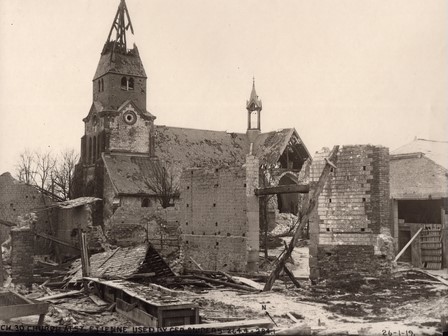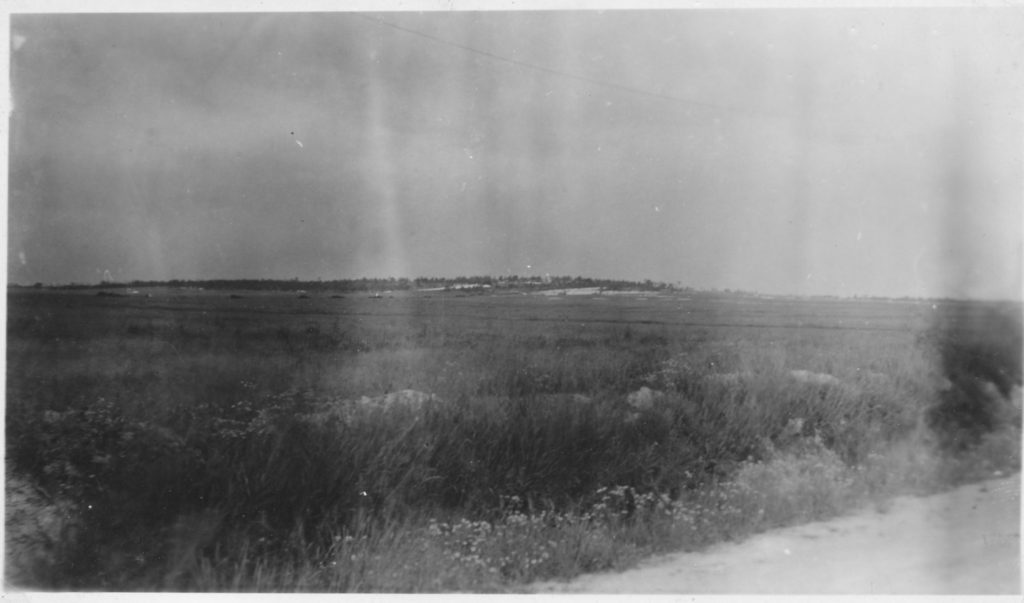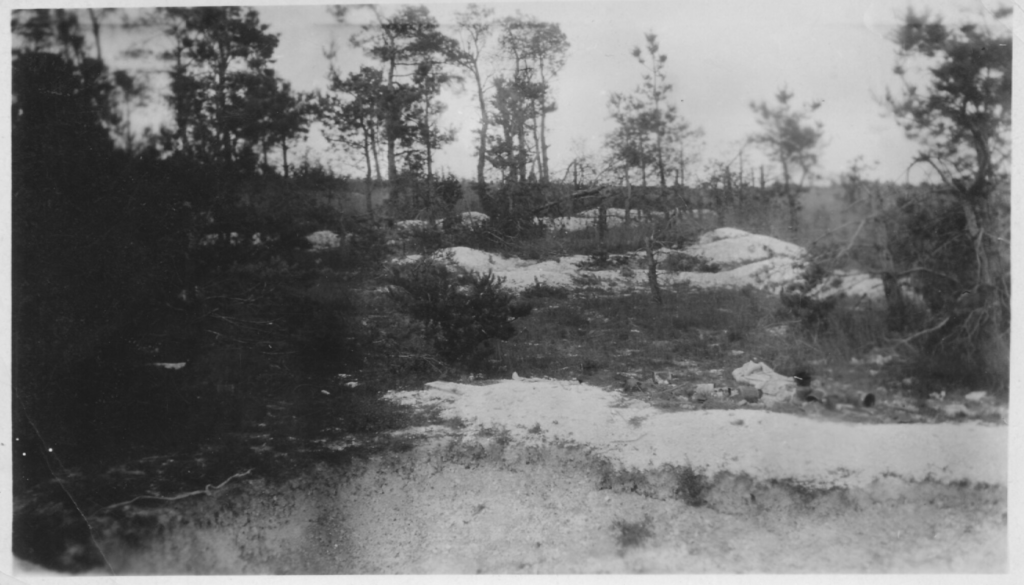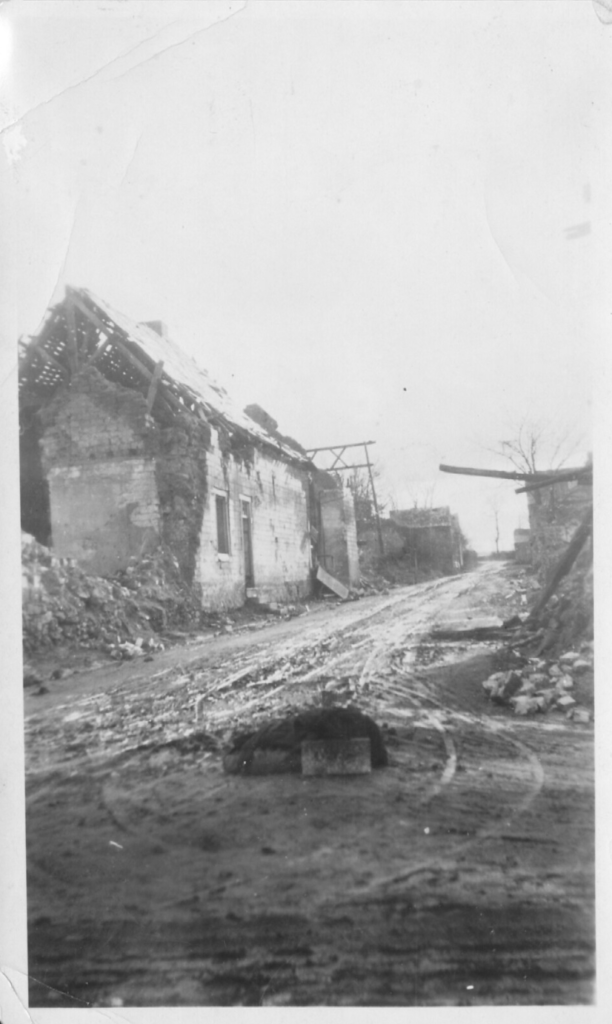
As darkness fell on October 8, 1918, soldiers of the 142nd Infantry regiment experienced the in-betweenness of the front line. At their current strength, they couldn’t advance. Because they were exposed to enemy fire, they couldn’t easily retreat. After a day of intense fighting, American forces had captured the town of Saint-Étienne and the German line of defenses that ran through it. Now, they were anticipating a counterattack.
German forces did counterattack earlier in the day, in the late afternoon. Soldiers of the 142nd under Captain Thomas Barton withdrew to the wooded hill about 600 yards from Saint-Étienne and dug in. The Germans gained some ground, but their counterattack was halted. Americans were hoping for support from their own artillery, but during the whole battle it was underwhelming.
A battalion of French tanks began the day with them; but coordination was poor between the French tankers and American infantrymen. The tanks did not keep up with the attack, and some of the machines were picked off by German artillery. When the tank battalion’s commander was killed, the tanks withdrew from the fight.

The first night
So it was left to the men on the new front line to dig in and hold. Everything was improvised; shell craters became shelters. Evening did not bring silence or comfort. The Americans were still taking artillery and small arms fire through the night. Temperatures dropped to freezing. Each soldier had one day’s ration when he started out two days before. Now, all their food and water were gone. Runners sent back to get food and supplies were under fire the whole way.
Exhausted by their introduction to combat, hungry soldiers curled up in their foxholes amid the shellfire and actually slept. Others kept guard as American and German patrols crawled across no man’s land to learn the disposition of their enemy. Doughboys who missed the signal to retreat tried to crawl back to the American line. However, several of these were picked up by German patrols and made prisoners.
Just before light on October 9th, men came up with crates filled with canned food. Frost covered the ground. Limbs were stiff and fingers were numb. If the Germans were going to attack, now would be the time. Shortly after dawn the American line experienced a furious shelling for about thirty minutes. But it seemed the enemy was not going to do more than fire at them with their cannon.

The next day
Now it was the 142nd’s turn. Behind the lines an ad hoc collection of the regiment’s reserve was formed. This included units who had gotten lost on the first day and individuals who had lost contact with their unit. At approximately 10:30 a.m. this force set out to reach the new front line. Reaching it under heavy fire, they forged ahead toward the German line. By this point German explosives and poison gas were overwhelming and the attack gained about 200 yards.
What followed was a sustained barrage of German artillery, made more accurate by German spotter aircraft. They still held a line of trenches about one thousand yards north of Saint-Étienne.
The second night
It grew dark once more, the second night. Once again, soldiers improved their makeshift defenses and thought of eating and drinking. Food and supplies were two miles back, and it took all night for small groups of men to carry them forward. The men who had advanced during the day found their position untenable. Reinforcements moved out of their foxholes and covered their retreat to the line established the night before.
Since the Americans could not move forward, did the Germans know it? And wasn’t this the perfect time for them to attack? This was on the mind of every doughboy hugging the earth around Saint-Étienne. During the cold night they strengthened their defenses, and dug deeper. Signalmen came up stringing telephone wire for better communication. Wounded men were carried back to the aid station. Men lay still in the cold and listened. They didn’t hear the German army getting ready to come down on their hasty fortifications. Instead they looked forward and saw large fires behind the German lines, three of them. German flares lit up the sky constantly. The men kept on their guard.

October 10th
By morning some food and water had reached the front line. The day brought orders for the First Battalion of the 142nd to move into the village and relieve soldiers and marines from the U.S. 2nd Division who had been holding it. The Second was moving out of the area after nine days of the most intense fighting. Saint-Étienne was closely observed by the Germans, and soldiers from First Battalion would have to slip in while under fire.
First the soldiers had to cross open land to reach town. Crawling forward in small groups, they sought foxholes and drainage ditches to cover their advance. The men moved into the village and spaced themselves, taking advantage of any protection nearby. Buildings, piles of rubble and shell holes provided shelter once the Germans caught sight of any movement. To relieve the men defending the cemetery posed another problem: it was out in the open. While every gun appeared to fire at them, First Battalion men would carefully time their dash toward the cemetery. Although German artillery was dialed in to every square foot of the village, they never shelled their own cemetery.

Under fire
As First Battalion men occupied the trenches in the cemetery, soldiers of Third Battalion also made their way under heavy fire through Saint-Étienne. Their destination was the front line north of town across the Arnes riverbed. This was the American position closest to the fourth line of German fortifications and it was very well defended.
Lieutenant Ben Chastaine of A Company recalls an order from behind the lines that contact be made with the enemy who was entrenched just ahead. The officer who got the order picked six men and they carefully made their way out of their holes and toward the German line. Chastaine continues:
“Crawling over every foot of the way the patrol made its way along a shallow ditch at the side of the road for a considerable distance in “no-man’s-land.” Suddenly from both sides and in front the little group became the target of the enemy snipers. Bullets in a perfect hail left the officer and four of his men on the ground while the other two made their way back as best they could. There was all the contact desired.”
